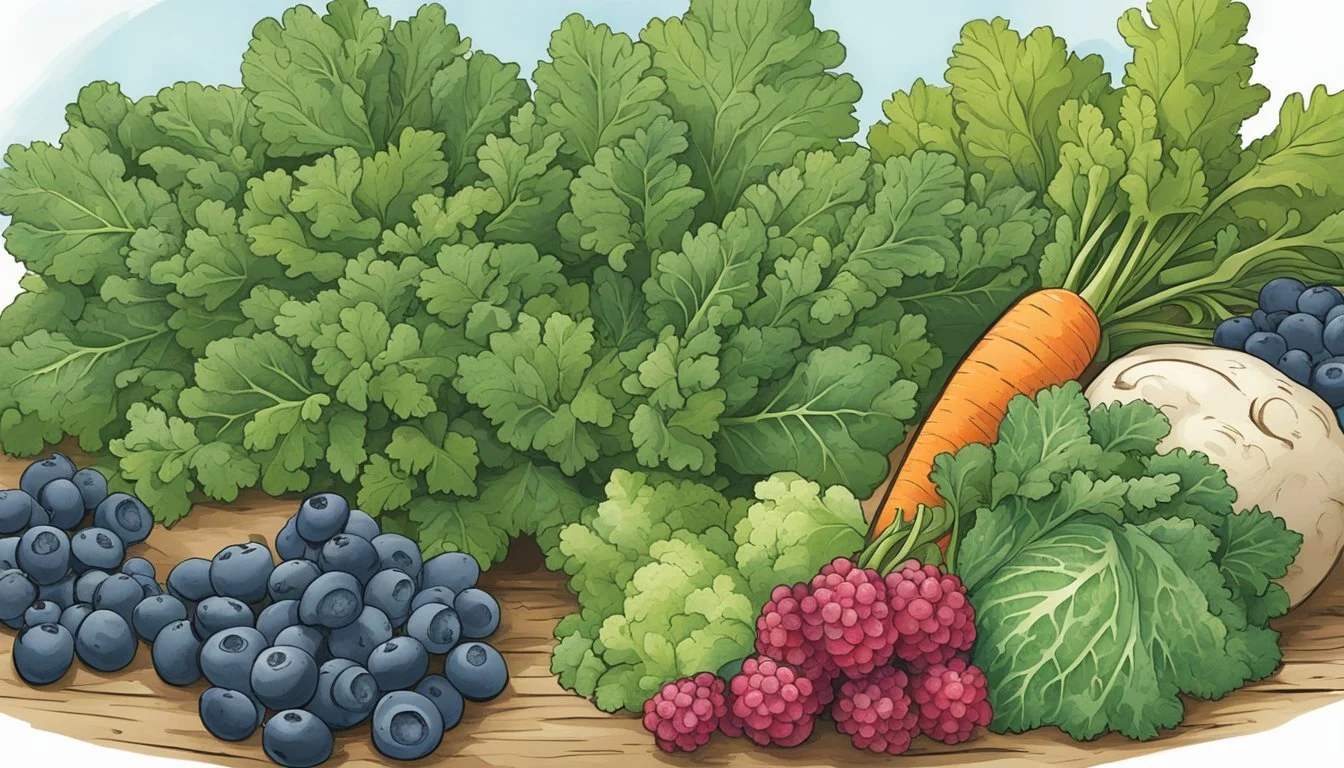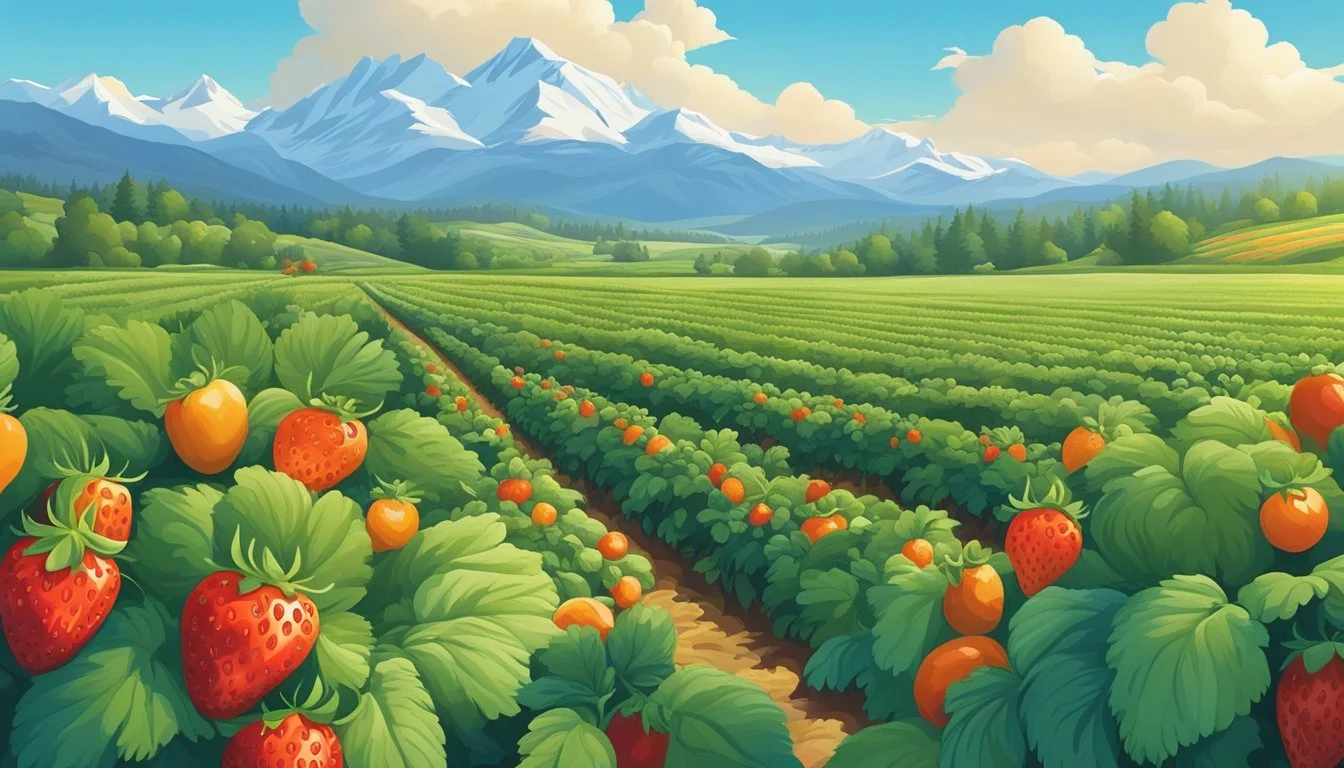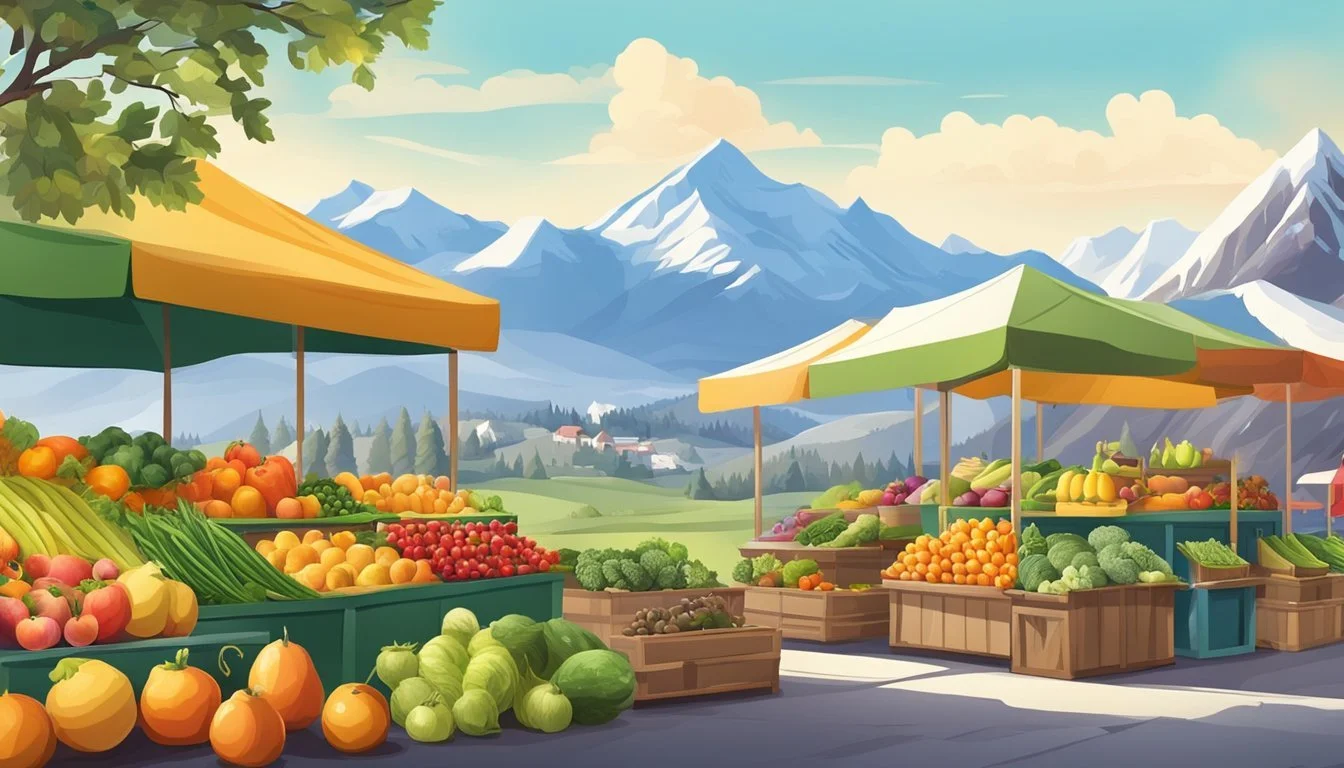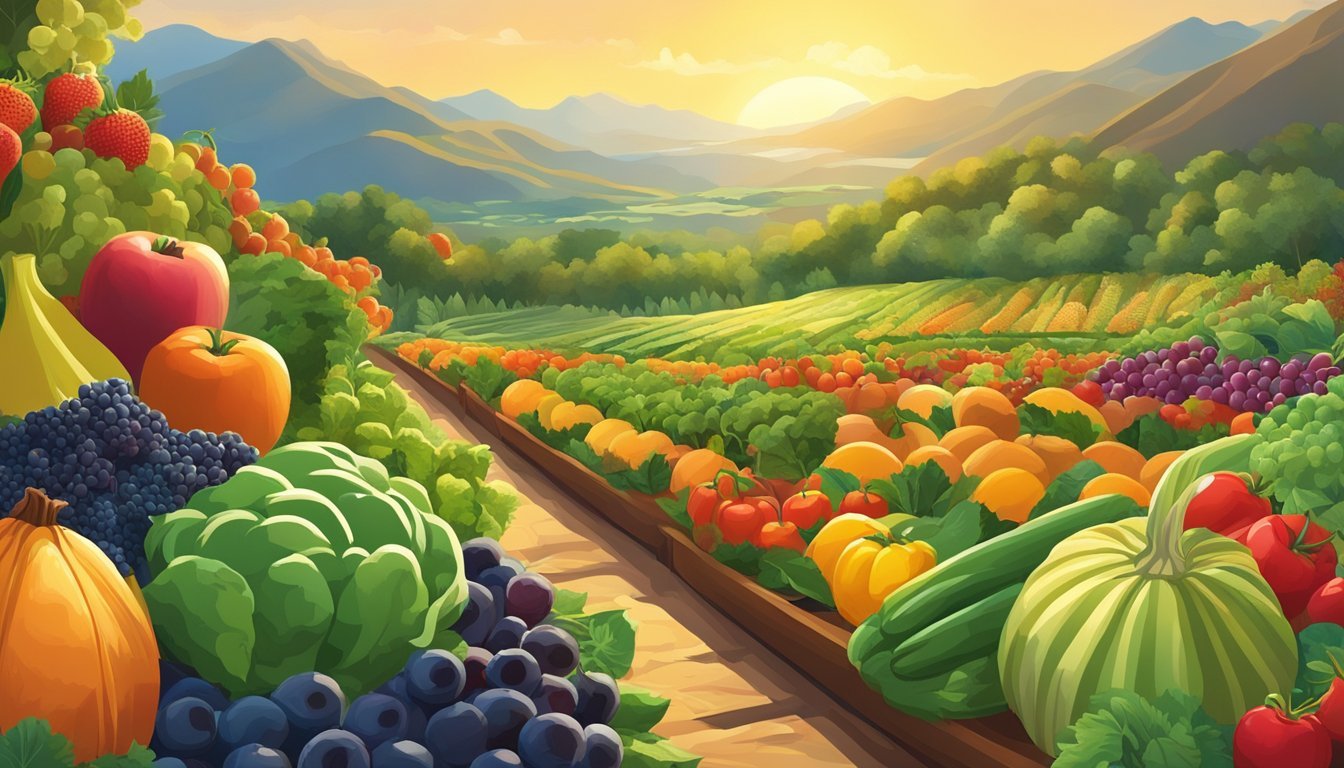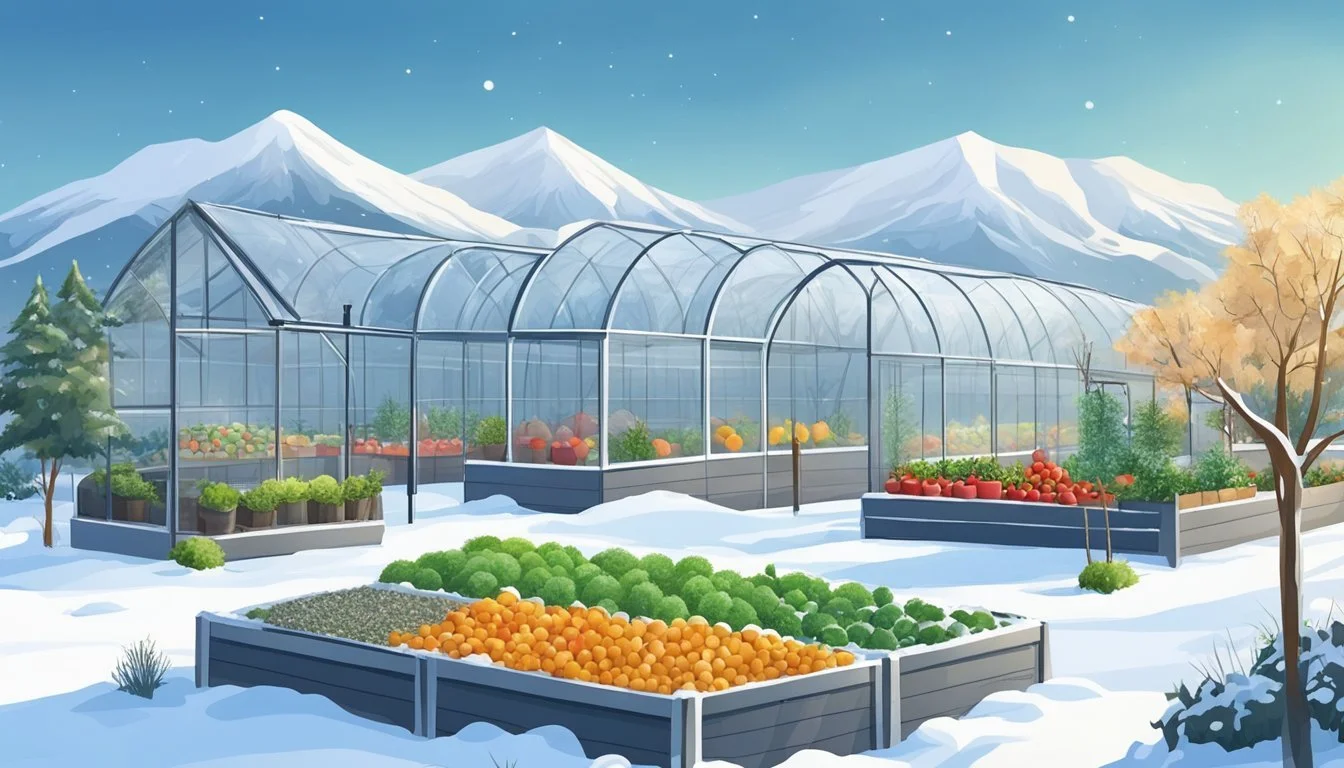Alaska Seasonal Fruit & Veg Guide
Your Ultimate Calendar
Alaska's unique position close to the Arctic Circle brings about extremes in climate and daylight, which dramatically influence its agricultural cycle. The concept of farm-to-table in Alaska is deeply seasonal, with a growing season that is both intense and fleeting due to these conditions. This guide takes a closer look at the Alaskan produce calendar, pinpointing what fruits and vegetables are available throughout the year, and how these periods of abundance interplay with the Alaskan lifestyle and culinary traditions.
During the short summer months, from June to September, Alaska's farms burst into rapid productivity under nearly 24 hours of sunlight, a phenomenon known as the 'midnight sun.' This period sees an array of crops including leafy greens, root vegetables, and some hardy fruits come into season. Residents and chefs alike eagerly anticipate this time, when the farm-to-table model truly comes to life, allowing for the freshest and most flavorful local ingredients to grace tables across the state.
In contrast, the long winters push Alaskans to rely on stored crops such as potatoes and carrots, as well as greenhouse-grown produce that can survive the colder months. Even though the colder seasons are less bountiful, they still play an essential role in the Alaskan food scene. The focus shifts to preserved, such as pickled or canned goods, and innovative greenhouse farming that can provide a measure of freshness amidst the arctic chill. Through these adaptations, Alaskans maintain a connection to locally grown produce year-round.
What’s in Season in Alaska Right Now?
Understanding Alaska's Unique Growing Seasons
Alaska's growing season is distinct from much of the lower 48 due to its northern latitude. This results in unique growing challenges and opportunities for local farmers and gardeners. Here’s a snapshot of what one can expect during Alaska's seasons in terms of farming:
Spring:
Sunlight increases, signaling the start of the growing season.
Farmers often begin indoor seed starting to prepare for transplanting once the ground thaws.
Cold-tolerant greens such as kale may become available as they can survive the still-cool temperatures.
Summer:
Characterized by long daylight hours, commonly referred to as the midnight sun, which accelerates plant growth.
This season is prime time for a variety of produce, including root vegetables and leafy greens.
Summer is the peak of Alaska's growing season, with harvesting starting in late summer for many crops.
Fall:
The onset of cooler temperatures and shorter days limits plant growth.
Harvesting continues for hardy crops that thrive in cool weather.
Producers rely on cold storage to extend the availability of their produce into the winter months.
Winter:
The growing season halts due to the freezing temperatures and limited sunlight.
Some root vegetables and hardy greens can still be available from cold storage.
Many farmers plan for the next season and maintain their equipment.
By understanding these seasonal shifts, one can appreciate the challenges faced by Alaska farmers and the resulting scheduling of crop availability.
Spring Bounty in Alaska
In the transition months of spring, Alaska begins to yield its first fresh produce after the long winter. Harvest times can vary by region, but certain hardy vegetables and herbs start to emerge in this season.
March to May: Early Season Harvest
Throughout March to May, Alaskans experience the onset of the growing season, marked by lengthening days that lead to a gradual warming of the soil. This period is known for the emergence of early spring vegetables as local farmers and gardeners take advantage of the milder temperatures.
March: The agricultural season is waking up with limited early crops due to the cold climate.
April: An increased variety of produce becomes available as the ground thaws and daylight hours extend.
May: The full swing of spring brings a greater abundance of Alaskan-grown produce.
Spring Vegetables & Herbs
Greens: One can typically find an assortment of leafy greens in Alaska during spring, including lettuce, kale, and spinach. These vegetables are among the first to thrive in the cooler temperatures of the Alaskan spring.
Lettuce: Grown in greenhouses and cold frames, it's one of the first greens to appear.
Kale: Robust and cold-tolerant, kale makes its way to the markets in the springtime.
Spinach: Another hardy green, spinach grows well in the chilled soil of the season.
Radishes: Fast-maturing radishes offer a crunchy, peppery addition to the spring palette.
Herbs: A variety of herbs begin to flourish, filling gardens with aroma and flavor.
Chives
Parsley
Cilantro
These plants adapt to the cooler Alaskan climate and have a relatively short growing cycle, making them ideal for spring cultivation.
Alaska’s Summer Harvest
Alaska's summer months provide an exceptional range of fresh produce, where long daylight hours foster rapid growth, offering a bounty of fruits, vegetables, and wild edibles that are central to the local farm-to-table experience.
June to August: Peak Season
During June through August, Alaska experiences its peak harvest season. The almost endless daylight known as the midnight sun encourages a vibrant array of crops to flourish.
Summer Fruits & Vegetables
Fruits: The summer warmth brings to ripeness a variety of berries. Strawberries generally appear in June, while raspberries, blueberries, and currants follow in July and August. Gooseberries also make a brief seasonal appearance.
Vegetables: The vegetable harvest sees an abundance of:
Peas
Sprouts
Zucchini
Summer squash
Alaskans often cultivate these robust vegetables in their backyard gardens and at local farms.
Foraging for Wild Edibles
Alaska's vast wilderness offers an array of wild edibles. Many Alaskans forage for:
Berries: Blueberries, raspberries, and other wild berries are commonly found.
Wild Rhubarb: In some regions, wild rhubarb can be found and is a popular ingredient for pies and jams.
While foraging, it's essential to correctly identify plants as some may be toxic. Those unfamiliar with foraging typically partake in guided tours or gather information from experienced locals.
Autumn Abundance in Alaska
In Alaska, the fall represents a critical time for harvesting and preparing vegetables and fruits for the winter months, making the most of the state's unique growing season before the frost sets in.
September to November: Harvesting and Storage
During the months of September to November, Alaskans are busy harvesting and storing an array of produce for the cold winter ahead. Root vegetables like potatoes, carrots (how long do carrots last?), and beets can withstand light frosts and are typically harvested in late September to early October. Storage methods are crucial; the produce is kept in cool, dark places, ensuring longevity. Cabbage and cauliflower also reach their peak during the fall, requiring the right combination of temperature and timing for optimal harvest and storage.
Fall Fruits & Vegetables
Apples: The hardy varieties such as Golden Delicious and Granny Smith thrive in the Alaskan climate, ripening by fall.
Cranberries: Found abundantly in Alaska, cranberries are harvested in September and October, often sweetened by the first frost.
Pumpkins: A fall classic, pumpkins are picked in late September to mid-October.
The fall weather lends itself to the cultivation of these fruits and vegetables, each with its own set of guidelines for harvesting and storage to withstand Alaska's harsh winters.
Winter Storage and Preservation
In Alaska, winter is a time when fresh produce is scarce, making storage and preservation techniques crucial for ensuring a supply of vegetables like turnips, rutabagas, and carrots. Proper methods can maintain the nutritional quality and flavor of these cold-resistant crops well into the colder months.
December to February: Overwintering Crops
During the coldest months of December to February, certain crops thrive under the protection of Alaska's snow. Root vegetables like turnips, rutabagas, celeriac (also known as celery root), and carrots are capable of overwintering in the ground. Cabbage, with its hardy leaves, can also endure the winter with adequate mulching. Residents often use these months to focus on the crops stored from fall harvest, relying on the natural cold storage provided by Alaska's winter climate.
Turnips: Harvested in late fall and stored in cool, humid conditions, turnips can last through the winter.
Cabbage: Harvest and store in cold, moist storage spaces to prolong freshness.
Carrots: Can be left in the ground with proper mulching or stored in a root cellar.
Techniques for Preservation
Preservation practices become essential in winter, as they extend the life of seasonal harvests. Techniques include:
Cold Storage: Utilize unheated basements, cellars, or insulated garage spaces to store root vegetables, where they remain dormant but fresh.
Freezing: Many Alaskan vegetables can be blanched and frozen for long-term storage, which is ideal for maintaining the taste and nutritional value.
Root Cellars: A traditional method that involves storing root vegetables in a cool, dark, and humid environment to maintain their edibility.
Alaskans count on these methods to enjoy locally-grown produce during the long winter months. Each technique is essential for a successful winter larder in an Alaskan household.
Local Food Scenes Across Alaska
In Alaska, the local food scene is defined by its varied regional produce and the community markets that bring Alaskans together. Through avenues like social media, residents and visitors alike stay connected to the freshest farm-to-table options across the state.
Regional Differences in Produce
Alaska's vast and varied landscape results in distinct regional specialties in produce. The Kenai Peninsula, for example, benefits from a maritime climate, where one can find abundant and diverse seafood from Kachemak Bay. In contrast, the interior regions such as Fairbanks experience a subarctic climate, which, despite a shorter growing season, can yield record-breaking harvests due to nearly constant summertime sunlight. Palmer, located in the Mat-Su Valley, is renowned for its sizeable cabbages and other vegetables due to rich soil and favorable growing conditions.
City and Community Markets
Each major city and many of the smaller communities host markets that become hubs for local produce. Anchorage, the largest city in Alaska, provides a variety of food markets where local vendors sell fresh, seasonal produce alongside artisanal food products. The Anchorage Market and Festival, among others, is a lively weekend event teeming with fresh Alaskan produce. In Homer and other regions, smaller markets and food festivals celebrate local harvests, connecting consumers directly with farmers and showcasing the state's rich culinary offerings.
Connecting Through Social Media
Facebook groups like Alaska Farm to Table create virtual marketplaces that connect Alaskan food producers with local consumers, facilitating the farm-to-table movement within the state. These online platforms allow for updates on available produce, market times and locations, and other relevant local food happenings. Through these social media connections, communities across Alaska are able to maintain a shared appreciation for locally sourced foods, highlighting seasonal availability and unique Alaskan food experiences.
Sustainable Practices in Alaskan Farming
In Alaska, farmers are adapting innovative, sustainable practices to overcome the challenges posed by the state's unique climate. These methods pave the way for a robust farm-to-table movement, delivering fresh, seasonal produce despite environmental hurdles.
Organic and Small-Scale Farming
Farmers in regions such as the Matanuska Valley are adopting organic methods that exclude the use of synthetic pesticides and fertilizers, creating a "beyond organic" standard of farming. These small-scale agricultural endeavors prioritize soil health and minimize their carbon footprint. Organic farming in Alaska also incorporates practices like crop rotation and green manuring to maintain soil fertility and prevent disease.
Managing Seasonal Challenges
Alaska's extreme growing seasons demand innovative solutions for year-round farming. Techniques such as extended daylight usage during the summer with nearly 24 hours of sunlight allow for an abundance of certain crops. To counter the harsh winters, farmers use controlled environments like greenhouses to grow produce like tomatoes and cucumbers, ensuring a steady supply of fresh vegetables throughout the year. Permafrost farms exploit the changing climate to transform previously unusable land into fertile ground, further extending Alaska's agricultural potential.
Alaskan Cuisines and Recipes
Alaskan cuisine artfully combines traditional cooking methods with contemporary styles, making the most of local and seasonal produce such as fresh seafood and wild berries. The state’s food culture reflects its rich history and the adaptability of its people.
Traditional and Contemporary Cooking
Alaskan culinary traditions have deep roots in indigenous practices, where the smoking and preserving of fish, such as salmon, (What wine goes well with salmon?) are time-honored techniques. Contemporary Alaskan chefs have taken these practices and infused them with modern culinary trends, creating unique dishes that speak to both history and innovation. For instance, Smoked Salmon Quiche marries the locally-smoked salmon with a classic quiche, showcasing both traditional and new flavors.
Following are recipes that highlight traditional Alaskan ingredients:
Smoked Salmon Quiche utilizes locally caught and smoked salmon.
Birch Syrup Glazed Salmon introduces the distinct taste of Alaskan birch syrup.
Making the Most of Seasonal Produce
Alaskan cooking emphasizes the use of seasonal produce, which in Alaska is defined by a very brief but intense growing period. Alaskans are known for their large cabbages and sweet carrots, which thrive in the extended daylight hours of summer. Cooking with these ingredients often means preparing them simply to highlight their freshness.
Seasonal Produce Highlights:
Spring: Preparations begin; early greens appear in some regions.
Summer: Berries, cabbages, carrots, and other vegetables peak.
Fall: Harvesting of root vegetables and last berries.
Winter: Stored and preserved foods dominate the table.
The use of birch syrup is a notable Alaskan twist on recipes that traditionally use other sweeteners, offering a distinct, regional flavor.
Season Ingredients Dish Ideas Spring Early Greens Simple salads, sautéed greens Summer Berries, Cabbage, Carrots Berry jams, slaws, roasted vegetables Fall Root Vegetables, Late Berries Stews, preserves Winter Preserved Foods Casseroles, smoked fish
This focus ensures Alaskan dishes not only burst with local flavors but also supports the local agriculture, making the dining experience in Alaska truly unique.
Seasonal Activities and Tourism
Alaska's seasonal shifts play a significant role in the agricultural produce available and have fostered a unique agritourism industry. Visitors can expect distinctly different experiences tailored to each season, as they explore various regions renowned for their fresh farm-to-table offerings and local activities.
Agricultural Tourism in Alaska
Alaska’s agritourism connects visitors with the state’s farming heritage throughout various regions, each with unique activities and agricultural practices. In Denali, tourists can take part in educational tours that showcase sustainable farming methods against the backdrop of breath-taking landscapes. Kachemak Bay offers a vibrant scene for farm-to-table cuisine, where visitors can indulge in fresh produce and seafood, including halibut, a local favorite. When visiting Talkeetna, travelers may engage with local farmers to learn more about the regional produce while enjoying a stunning view of Denali, North America's tallest peak.
Planning Your Visit by the Seasons
Travelers should plan their Alaska visits according to the seasonal produce and activities available:
Spring: A time to witness the rebirth of flora, where one might visit the Turnagain Arm region for spring greens and the beginning of the fishing seasons.
Summer: Full of festivals and fairs, summer beckons with the promise of abundant harvests. The Alaska Wildlife Conservation Center near Turnagain Arm offers a window into Alaska's diverse fauna.
Autumn: As fall colors peak, so do harvest festivals. This is an excellent time for travelers to venture to various farms and orchards for apple picking and hayrides.
Winter: While not a traditional produce season, winter offers unique experiences such as customizable itineraries for aurora viewing and winter sports.
Visitors are encouraged to contact local tourism boards to create customized itineraries that highlight the best of Alaskan agritourism and seasonal activities across the state’s diverse areas and cities.
Preparing and Planning Your Garden
When preparing and planning a garden in Alaska, gardeners must be well-informed about the specific soil and climate conditions of their region. Choosing the appropriate crops and varieties that can thrive in these conditions is crucial for a successful harvest.
Understanding Soil and Climate Factors
Alaska's soil and climate conditions are unique and pose specific challenges for gardening. The soil can be silty, peaty, or even glacier-fed, with varying pH levels and nutrient profiles. Gardeners should test their soil to determine its type and adjust with organic matter as necessary. The climate is characterized by long daylight hours in summer, which can lead to massive growth spurts for certain vegetables and fruits. However, the risk of frost and snow extends well into spring and arrives early in fall, shortening the growing season. Frost protection methods, such as using hoop houses and greenhouses, are essential for extending the growing periods.
Choosing the Right Crops and Varieties
Selecting crops that are suited to Alaska's short and cool growing season is fundamental. Gardeners can plant cold-hardy vegetables such as:
Carrots: Opt for varieties like 'Nantes' or 'Alaska' which are known for sweet flavor and cold tolerance.
Potatoes: They flourish in cool soil; choose fast-maturing types like 'Yukon Gold' or 'Red Pontiac'.
For fruit cultivation, it's important to have cold-tolerant fruit varieties. While apples can grow in Alaska, selections like the 'Rescue' or 'Norland' are hardier choices given the climate. It's also essential to choose fruit trees and bushes that have a low chill requirement and are disease-resistant to capitalize on the long summer days. Gardeners should plan their planting calendar carefully, favoring early planting where possible and using protective methods to shield against the cold.
Guide to Year-Round Gardening
Alaska's harsh climate presents unique challenges for year-round gardening. Gardeners can overcome these challenges using controlled environment agriculture and greenhouse cultivation to extend growing seasons and ensure a consistent supply of fresh produce.
Indoor and Controlled Environment Agriculture
Controlled Environment Agriculture (CEA) is an advanced approach that allows for the precise management of light, temperature, and humidity to grow plants any time of the year. In Alaska, CEA is especially beneficial for maintaining optimal growing conditions during the long winters. Here's what it typically involves:
Lighting: LED grow lights to mimic the spectrum of sunlight.
Climate Control: Systems to manage temperature and humidity levels.
Hydroponics or Aeroponics: Soil-less growing methods that can yield more produce in limited space.
Utilizing Greenhouses and High Tunnels
Greenhouses provide an insulated environment that can retain heat even when outside temperatures are freezing. Alaskans can grow a variety of cool-season crops in greenhouses throughout the year. Planting in high tunnels, or unheated greenhouses, can also extend the growing season for many vegetables. Key considerations include:
Insulation: Using double-layered plastic or polycarbonate panels for better heat retention.
Ventilation: Installing vents or fans to regulate temperature and maintain air circulation.
Heating: Employing heaters if necessary, especially during Alaska's winter months.
By combining the techniques of controlled environment agriculture with greenhouse cultivation, Alaskans are able to practice gardening all year round and harvest fresh, locally-grown produce no matter the season.
Conclusion
In Alaska, the agricultural season is distinctly marked by a brief but bountiful period, primarily from late spring through early fall. The state's unique growing conditions yield a variety of fruits and vegetables celebrated for their vibrant taste and quality.
Alaskans can anticipate fresh produce with an understanding of the seasonal availability:
Spring brings early greens such as kale and herbs.
Summer offers a peak time for berries, including strawberries and blueberries, alongside a rich assortment of vegetables like zucchini and broccoli.
Fall is the season of harvest for root vegetables such as carrots and potatoes, which often carry on into the winter.
Alaskans are encouraged to support local agriculture by seeking out fresh, in-season produce, which not only ensures optimal flavor but also benefits the environment by reducing transportation needs and supporting local economies.
Eating seasonally aligns consumers with the natural cycles of their environment, embedding a connection to the rhythm of nature. The Alaska Produce Calendar is a valuable resource for anyone looking to enjoy the freshest local offerings and can be a practical guide for both consumers and producers aiming to make informed decisions about locally sourced foods.
Local produce is a culinary delight, with taste comparisons consistently favoring Alaskan-grown goods for their freshness. This preference reinforces the value of farm-to-table practices in the state.
In summary, embracing the seasonality of Alaskan produce enriches the dining experience, supports the local agricultural community, and contributes to a sustainable lifestyle.


